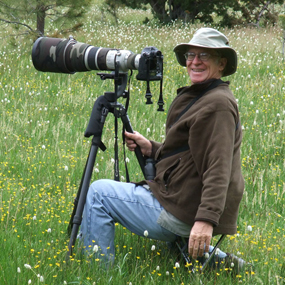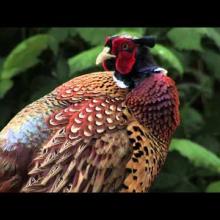

Join BirdNote tomorrow, November 30th!
Illustrator David Sibley and actor H. Jon Benjamin will face off in the bird illustration battle of the century during BirdNote's Year-end Celebration and Auction!
The Ring-necked Pheasant is likely the best-known bird in North America that isn’t native to the continent. Indigenous to Asia, Ring-necked Pheasants were introduced to Oregon in 1881. The birds thrived in rural landscapes for many years, but modern industrial farming practices have diminished pheasant habitat. In some areas, however, wildlife agencies are working with private landowners to create favorable habitats for pheasants, giving the birds the cover they need for feeding, nesting, and roosting through the seasons.
Find out what’s new with BirdNote - subscribe to our newsletter at BirdNote.org.
BirdNote®
Ring-necked Pheasants in the Wild
Written by Bob Sundstrom
This is BirdNote.
[Ring-necked Pheasant crowing]
Even though the Ring-necked Pheasant can be found across a large part of the United States, it isn’t actually native to this continent. Back in 1881, an American living in Shanghai sent a shipment of pheasants from China to Oregon to start a breeding colony. From there, the birds spread throughout the Northwest. Others were introduced to the Midwest and elsewhere in the country.
[Ring-necked Pheasant crowing; http://macaulaylibrary.org/audio/105675 ]
Ring-necked Pheasants owe much of their expansion across the continent to their popularity as game birds. Hunters and birders alike admire the cock pheasant’s spectacular, ornate feathering. And for many years, pheasants thrived in the country’s rural landscapes. Small farms offered hay fields and fallow acres to find food, and hedgerows and stands of trees provided cover.
[Ring-necked Pheasant crowing]
Today, though, industrial farming practices leave less and less room for pheasants. Hedgerows are disappearing. Weedy cover is burned or sprayed with weed killer. And nesting sites are lost to more frequent hay-mowing or overgrazing by livestock.
But there is hope for wild pheasants: in some areas of the country, wildlife agencies are working with private landowners to protect the habitat these birds need for feeding, nesting, and roosting through the seasons.
[Ring-necked Pheasant crowing]
For BirdNote, I'm Michael Stein.
Find out what’s new with BirdNote. Subscribe to our newsletter, at birdnote dot org.
###
Bird sounds provided by The Macaulay Library of Natural Sounds at the Cornell Lab of Ornithology, Ithaca, New York. Recorded by G.A. Keller.
Producer: John Kessler
Executive Producer: Sallie Bodie
Editor: Ashley Ahearn
Associate Producer: Ellen Blackstone
Assistant Producer: Mark Bramhill
Narrator: Michael Stein
BirdNote’s theme was composed and played by Nancy Rumbel and John Kessler.
© 2019 BirdNote October 2014 / 2019 / 2021
ID# RNEP-02-2014-10-10 RNEP-02b
http://www.ct.gov/deep/cwp/view.asp?a=2723&q=326060
example providing guidelines for landowners to help conserve pheasants
http://animaldiversity.ummz.umich.edu/accounts/Phasianus_colchicus/
useful background link
http://www.historylink.org/index.cfm?DisplayPage=output.cfm&file_id=8444





